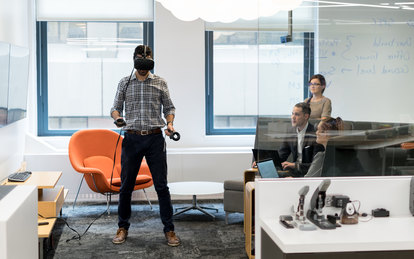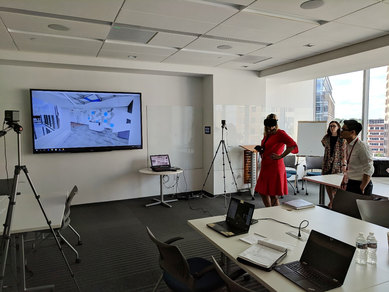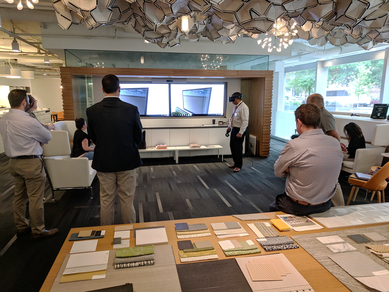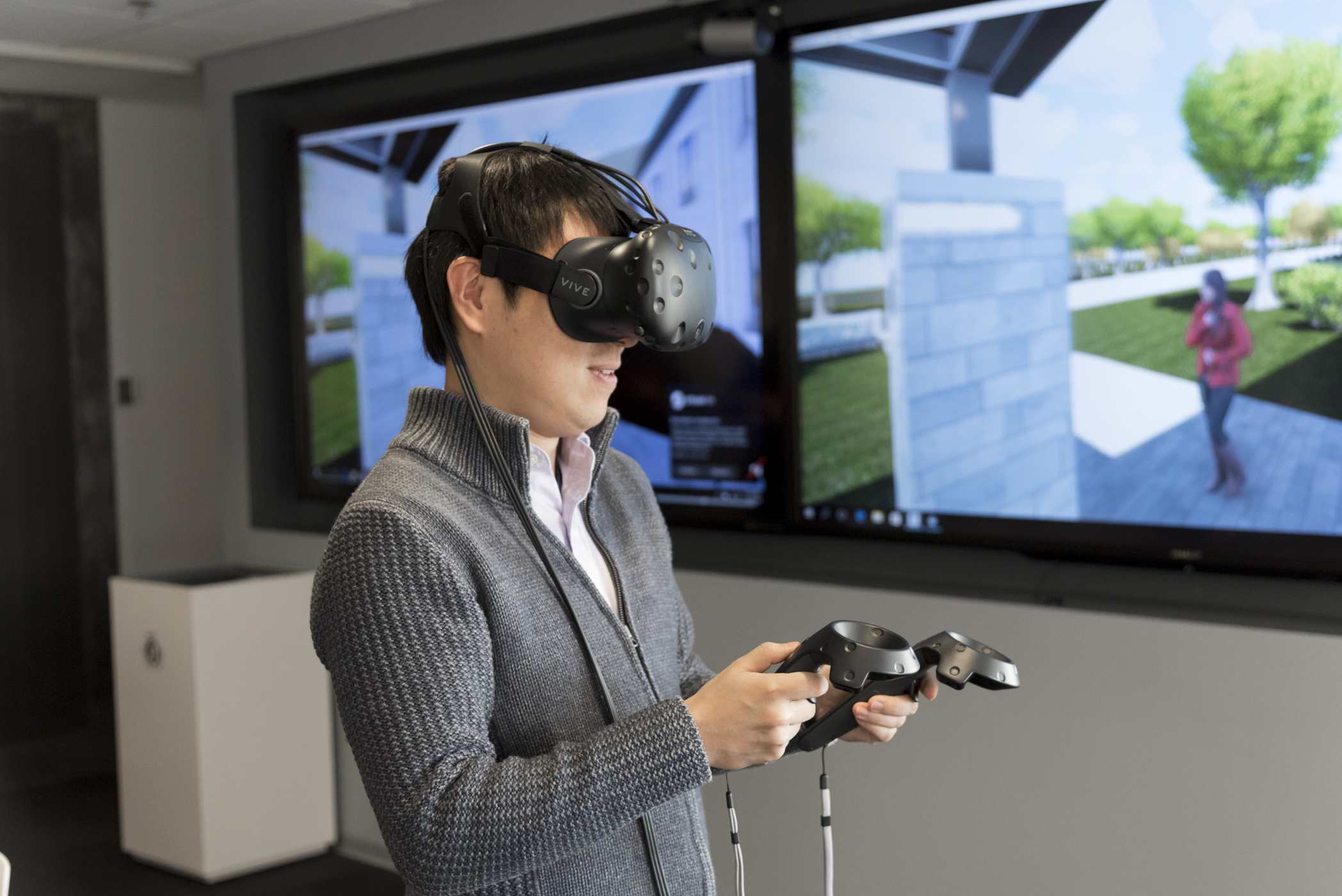Virtual Reality is Here to Stay

Virtual Reality Space at SmithGroup’s Chicago Office
This article, authored by David Fersh of SmithGroup, was previously published in Work Design Magazine.
Learning by doing is a concept that most people understand intuitively. It’s commonly accepted in the educational world and scientific studies prove that the human brain is more effectively activated through the process of enacting an action than by passively observing. It is the reason why you can be a passenger on the same trip numerous times but have trouble remembering the precise directions until moving to the driver’s seat.
For designers, learning by doing can be a lengthy process – a project must move through design, documentation and construction prior to seeing final results. Projects can take years to be completed, and only then can we fully assess its success and failures and apply them to the next project. It is the reason that an experienced designer is so highly valued – they are experts at translating two dimensional drawings and renderings into the built environment.
For a young designer, the translation between traditional drawings and the built environment is much more difficult to learn. Thankfully, new tools allow us to bridge this gap and expedite the learning cycle. Virtual Reality (VR) allows designers to receive immediate visual feedback on the look and feel of a space during conceptualization. Six degrees of freedom (6DoF) is defined as the freedom of movement of the body in a three-dimensional space. Through 6 DoF virtual reality, users can walk freely through a space, sit, stand or lay down on the floor and the environment will react appropriately. This creates full immersion and helps to encode new experiences in the brain. Using this technology also gives designers the ability to test schemes and instantly understand plan/layout decisions in a virtual environment. This tool dramatically flattens the young designer’s once steep learning curve. The feel of a 5-foot versus a 6-foot corridor, the impact of an atrium, or position of a structural column can all be felt virtually and hardwired into your brain in a way previously only years of experience could yield.
Virtual reality can aid in more practical design decisions as well. While working on the design of a check-in kiosk for the Social Security Administration, SmithGroup’s design team took advantage of a virtual environment to help simulate the experience of a seated wheelchair user. Before this technology, the most effective way to test the user experience was through a true scale mock-up, which takes significantly more time and money. Now, through virtual reality, we can ensure our designs create a successful user experience, allowing us the ability to adjust before even considering building a mockup.
As valuable as virtual reality is to designers, our clients truly gain the largest benefits. Two dimensional drawings and renderings are not intuitive and can be misleading. Virtual reality is a true reflection of the design, unaltered with camera angles or photoshop tricks. The user has the ability to move freely through a space and understand what it feels like through an interactive experience. Our iterative design process allows for that experience to be easily repeated many times over.
With this technology, our traditional design documentation process had to be adapted to meet the needs of real time feedback. The steppingstone that allowed for this adaptation was the transition from purely 2D drawings to digital 3D models with the adoption of Building Information Modeling (BIM). Creating an accurate digital model for every project provides a vast amount of visual data that can be leveraged. While BIM is now the industry standard, the level of detail included in documentation models varies widely.
In the past, designers used BIM as a documentation tool only. Often, materiality and lighting information was included in the model, but not all projects were modeled accurately because it was either not necessary for documentation or it wasn’t an efficient use of computing power. Today, improved processing power and software means that including exact finishes and furniture in our documentation models is extremely advantageous for most design exercises. The same model used to produce a construction document set can be used to create a realistic virtual reality walkthrough with only a few clicks of the mouse. For our clients, this means greater transparency and decision-making abilities in the design process. We can quickly and accurately share an entire experience as if we were walking through the site. The ease of decision making has been a game changer. If a client is wavering on a decision, immersing them in a virtual environment is priceless. Each SmithGroup office is equipped with an area for virtual reality walkthroughs. We also have the ability to bring the equipment to the client in any location. This is advantageous to both the design team and client, giving both parties confidence through an informed decision-making process.

Virtual Reality Mobile Kit in use at client site.

Virtual Reality Client Session
Now, as with anything else, there are some drawbacks. One of the biggest complaints I hear from colleagues about virtual reality is that it gives clients the ability to comment on design decisions that the design team did not want comments on. This is important! Traditional presentation methods show an idealized picture, with precise camera placements and photoshop tricks necessary to properly curate the look and feel of the space. Virtual reality is an honest spatial interpretation. While receiving comments during the design process saves potential re-work or disappointment in a finished space, the client might also change something the designer had his/her heart set on.
Beyond abstract spatial understanding of space, virtual reality can serve as a realistic gauge of functionality. At SmithGroup, our healthcare designers were amongst the first market to use VR for just this reason. Taking advantage of the same software used to create the latest video games, we are able to program an entire operating room with moving parts and gravity for doctors and nurses to test. This technology can save hundreds of thousands of dollars by eliminating mockups and catching mistakes early in the design process. In a workplace environment, our simulations often don’t need to be as complicated to be valuable. Virtually sitting at a workstation can ensure elements are spaced comfortably and desired sightlines are maintained between workspaces.
A common presentation technique we use is to setup a virtual walkthrough side by side with real materials. This makes the often-painful process of material selection and approval seamless. Our clients can immediately understand the location and use of each material, and then have the opportunity to touch material samples and approve or reject each selection. This makes for an intuitive selection process with no surprises when construction is completed.
The adoption of virtual reality has been rapid since its mainstream debut in 2016. Designers have recognized its value in their creative process and clients are beginning to understand its immense value as a communication tool. As the technology continues to improve and the quality of experience is raised, this tool will become an industry standard, as it is not only a valuable learning tool for the design, but a priceless communication tool between design team and client.
